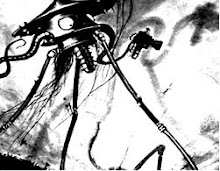The New Sound Is Robot Music
I posted earlier this week about an article in Word Magazine and promised some follow-up commentary. The Word Magazine article shed some light onto the other factors, besides the loudness war, that are effecting the way that music is recorded nowadays. I was particularly interested in the the discussion about the practice of cutting and pasting track clips instead of recording a track in one take, as well as the use of Auto Tune.
What does this mean? No mistakes. No variation. No style, period. How can I tell the difference between two guitarists if both are picking the best played riff of their track and looping it throughout the song? Where are the quirks, or slight variations to distance musicians' sound from one another? And with Auto Tune, I'm guaranteed a pitch-perfect sound. This program removes the human-factor in live recordings. I might as well be listening to a sampling machine; musicians might as well just program their songs into Pro Tools. What's the point of a live recording?
I see this new trend of recording, mixing, and mastering as removing the musicians from the picture. The only thing keeping them there, as of now, is the live performance. If fans didn't continue going to live shows there'd be no reason to keep the flesh and blood around. Musicians would be programmers, and fans wouldn't know the difference because they'd just be downloading the music from iTunes to be the soundtrack of their morning commute.
And with this new robotic method of producing records we have the loudness war. Doesn't seem like much of a war to me, though, as pretty much all the mainstream acts and labels are going this way. I mean, who's fighting this at the top? So it's really the loudness trend, since there are no signs of it slowing. In doing further research, I came across this blog post that chronicles the change in sound of Rush records over the years.
A long and informative commentary, especially near the middle of the post where the author makes an excellent point through use of example. The point the author is highlighting is one that has been stated numerous times in the past -- that by increasing the volume, listeners will being to fatigue. That's exactly what happens when, as in the post's example, a reader is subjected to large, bold text in all caps for an extended period of time. The writing is devoid of any form of dynamics, just as the heavily compressed audio file is stripped of all of its dynamics. Too much of this and the brain is unable to process the sounds -- there's nothing left of make any of the sounds distinct.
The music industry only appears to be interested in continuing this trend. Mainstream records are increasingly unlistenable, aside from the actual music, because of the way the sounds are recorded, mixed, and mastered.
Music is no longer something that is listened to alone. That is to say, music is background sounds for many people. People listen to their iPods while commuting to work, walking the street, or exercising. People listen to music more in the cars than at home. The point is that the act of listening is not the primary action taking place -- it is secondary to the other things that people are focusing on.
Not only that, but music now has many more forms of entertainment media to compete with than in years past. Cable/satellite television, streaming internet media, video games, and DVDs are only a few of the new entertainment media that music must compete with for the attention of its listeners. The industry has deemed it necessary to make records louder in order to be heard over all the other noises vying for our attention. This is why I don't think we're going to see dynamics brought back into mainstream recordings.
Fidelity is dead.



No comments:
Post a Comment